Taxation Law Assignment - Income, Fringe Benefits, and Capital Gains
VerifiedAdded on 2021/05/27
|8
|1802
|193
Homework Assignment
AI Summary
This taxation law assignment solution addresses several key areas of Australian taxation. It begins with an analysis of income from personal exertion, determining whether payments received by a mountain climber for her life story, manuscript, and photographs are assessable income. The solution then calculates the taxable value of a car fringe benefit using the statutory formula. Next, it explores the effect of a parent lending money to their son, considering whether the additional repayment is assessable income, and addresses the principle of mutuality. Finally, the assignment delves into capital gains tax (CGT), calculating Scott's net capital gain or loss from the sale of a property, and analyzing how the outcome would differ if the property was sold to his daughter or owned by a company. The document concludes with a list of relevant references.
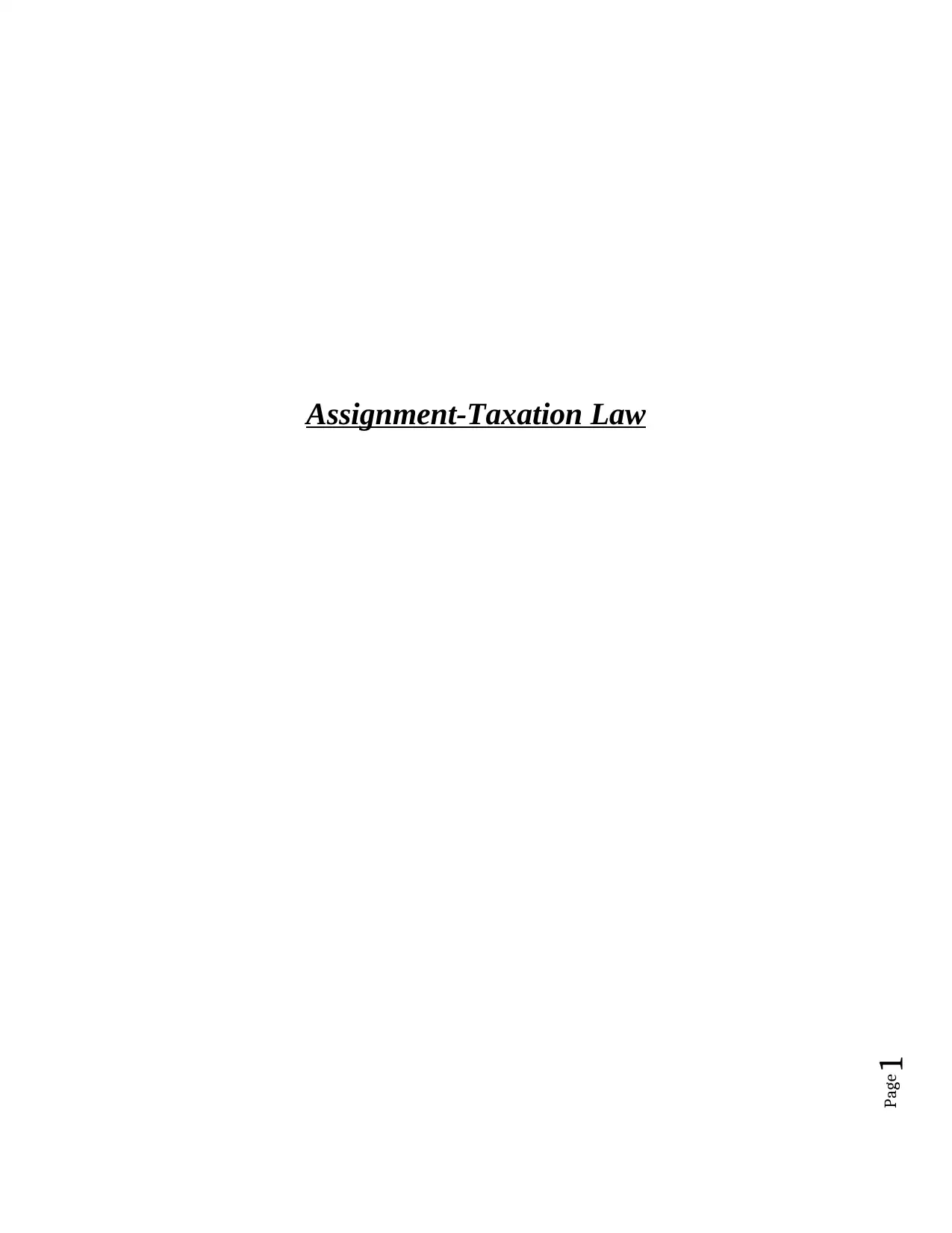
Page1
Assignment-Taxation Law
Assignment-Taxation Law
Paraphrase This Document
Need a fresh take? Get an instant paraphrase of this document with our AI Paraphraser
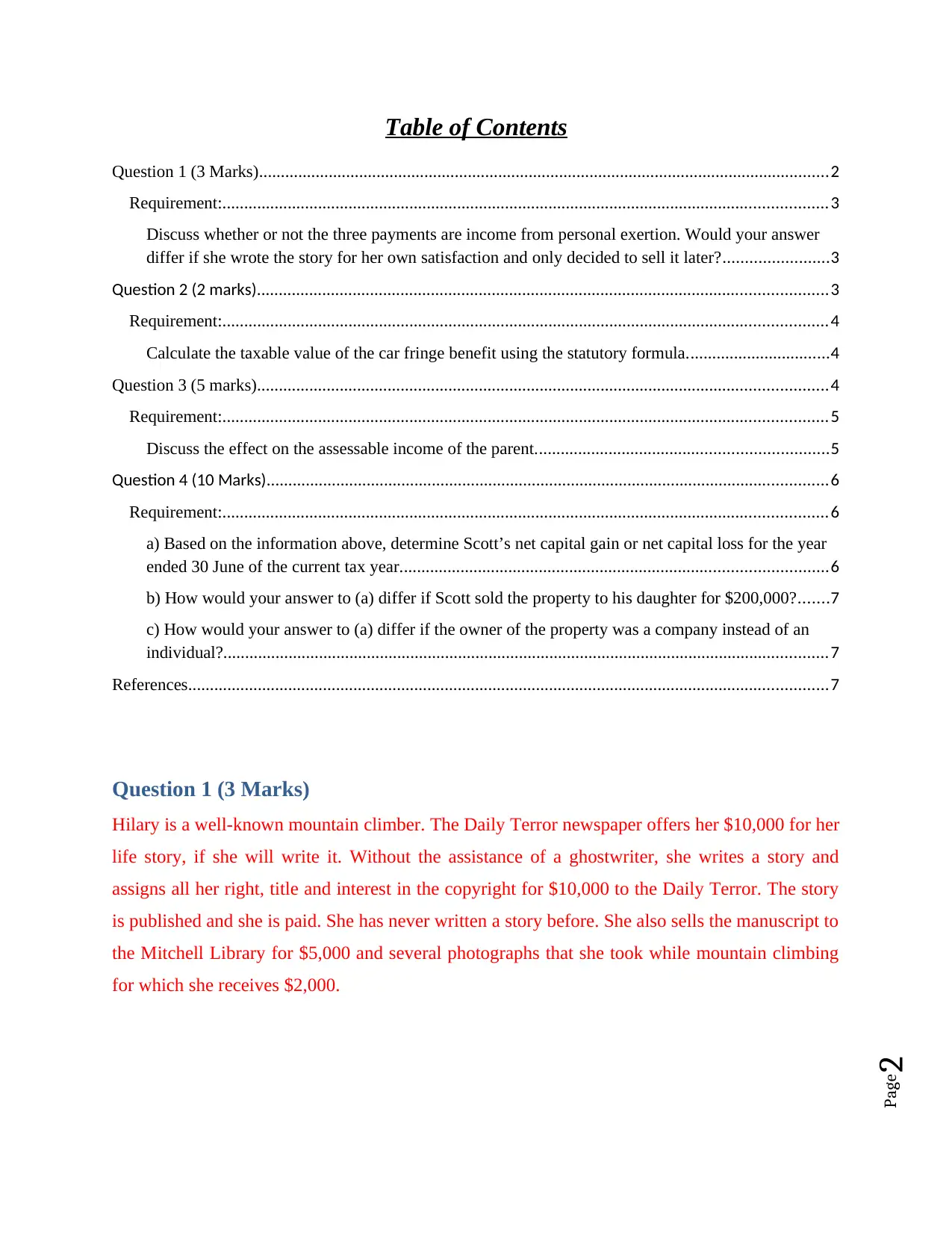
Page2
Table of Contents
Question 1 (3 Marks)...................................................................................................................................2
Requirement:...........................................................................................................................................3
Discuss whether or not the three payments are income from personal exertion. Would your answer
differ if she wrote the story for her own satisfaction and only decided to sell it later?........................3
Question 2 (2 marks)...................................................................................................................................3
Requirement:...........................................................................................................................................4
Calculate the taxable value of the car fringe benefit using the statutory formula.................................4
Question 3 (5 marks)...................................................................................................................................4
Requirement:...........................................................................................................................................5
Discuss the effect on the assessable income of the parent...................................................................5
Question 4 (10 Marks).................................................................................................................................6
Requirement:...........................................................................................................................................6
a) Based on the information above, determine Scott’s net capital gain or net capital loss for the year
ended 30 June of the current tax year..................................................................................................6
b) How would your answer to (a) differ if Scott sold the property to his daughter for $200,000?.......7
c) How would your answer to (a) differ if the owner of the property was a company instead of an
individual?...........................................................................................................................................7
References...................................................................................................................................................7
Question 1 (3 Marks)
Hilary is a well-known mountain climber. The Daily Terror newspaper offers her $10,000 for her
life story, if she will write it. Without the assistance of a ghostwriter, she writes a story and
assigns all her right, title and interest in the copyright for $10,000 to the Daily Terror. The story
is published and she is paid. She has never written a story before. She also sells the manuscript to
the Mitchell Library for $5,000 and several photographs that she took while mountain climbing
for which she receives $2,000.
Table of Contents
Question 1 (3 Marks)...................................................................................................................................2
Requirement:...........................................................................................................................................3
Discuss whether or not the three payments are income from personal exertion. Would your answer
differ if she wrote the story for her own satisfaction and only decided to sell it later?........................3
Question 2 (2 marks)...................................................................................................................................3
Requirement:...........................................................................................................................................4
Calculate the taxable value of the car fringe benefit using the statutory formula.................................4
Question 3 (5 marks)...................................................................................................................................4
Requirement:...........................................................................................................................................5
Discuss the effect on the assessable income of the parent...................................................................5
Question 4 (10 Marks).................................................................................................................................6
Requirement:...........................................................................................................................................6
a) Based on the information above, determine Scott’s net capital gain or net capital loss for the year
ended 30 June of the current tax year..................................................................................................6
b) How would your answer to (a) differ if Scott sold the property to his daughter for $200,000?.......7
c) How would your answer to (a) differ if the owner of the property was a company instead of an
individual?...........................................................................................................................................7
References...................................................................................................................................................7
Question 1 (3 Marks)
Hilary is a well-known mountain climber. The Daily Terror newspaper offers her $10,000 for her
life story, if she will write it. Without the assistance of a ghostwriter, she writes a story and
assigns all her right, title and interest in the copyright for $10,000 to the Daily Terror. The story
is published and she is paid. She has never written a story before. She also sells the manuscript to
the Mitchell Library for $5,000 and several photographs that she took while mountain climbing
for which she receives $2,000.
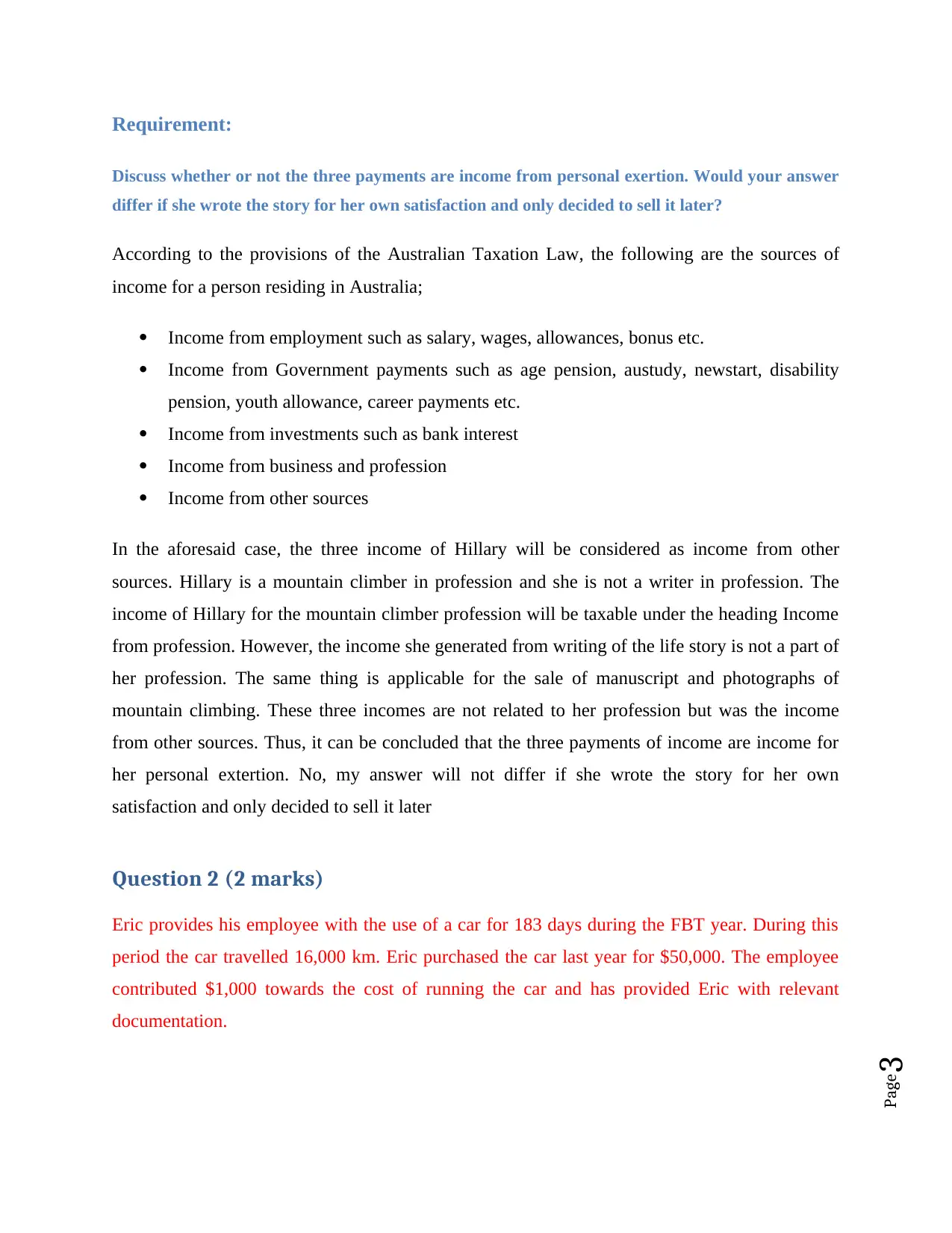
Page3
Requirement:
Discuss whether or not the three payments are income from personal exertion. Would your answer
differ if she wrote the story for her own satisfaction and only decided to sell it later?
According to the provisions of the Australian Taxation Law, the following are the sources of
income for a person residing in Australia;
Income from employment such as salary, wages, allowances, bonus etc.
Income from Government payments such as age pension, austudy, newstart, disability
pension, youth allowance, career payments etc.
Income from investments such as bank interest
Income from business and profession
Income from other sources
In the aforesaid case, the three income of Hillary will be considered as income from other
sources. Hillary is a mountain climber in profession and she is not a writer in profession. The
income of Hillary for the mountain climber profession will be taxable under the heading Income
from profession. However, the income she generated from writing of the life story is not a part of
her profession. The same thing is applicable for the sale of manuscript and photographs of
mountain climbing. These three incomes are not related to her profession but was the income
from other sources. Thus, it can be concluded that the three payments of income are income for
her personal extertion. No, my answer will not differ if she wrote the story for her own
satisfaction and only decided to sell it later
Question 2 (2 marks)
Eric provides his employee with the use of a car for 183 days during the FBT year. During this
period the car travelled 16,000 km. Eric purchased the car last year for $50,000. The employee
contributed $1,000 towards the cost of running the car and has provided Eric with relevant
documentation.
Requirement:
Discuss whether or not the three payments are income from personal exertion. Would your answer
differ if she wrote the story for her own satisfaction and only decided to sell it later?
According to the provisions of the Australian Taxation Law, the following are the sources of
income for a person residing in Australia;
Income from employment such as salary, wages, allowances, bonus etc.
Income from Government payments such as age pension, austudy, newstart, disability
pension, youth allowance, career payments etc.
Income from investments such as bank interest
Income from business and profession
Income from other sources
In the aforesaid case, the three income of Hillary will be considered as income from other
sources. Hillary is a mountain climber in profession and she is not a writer in profession. The
income of Hillary for the mountain climber profession will be taxable under the heading Income
from profession. However, the income she generated from writing of the life story is not a part of
her profession. The same thing is applicable for the sale of manuscript and photographs of
mountain climbing. These three incomes are not related to her profession but was the income
from other sources. Thus, it can be concluded that the three payments of income are income for
her personal extertion. No, my answer will not differ if she wrote the story for her own
satisfaction and only decided to sell it later
Question 2 (2 marks)
Eric provides his employee with the use of a car for 183 days during the FBT year. During this
period the car travelled 16,000 km. Eric purchased the car last year for $50,000. The employee
contributed $1,000 towards the cost of running the car and has provided Eric with relevant
documentation.
⊘ This is a preview!⊘
Do you want full access?
Subscribe today to unlock all pages.

Trusted by 1+ million students worldwide
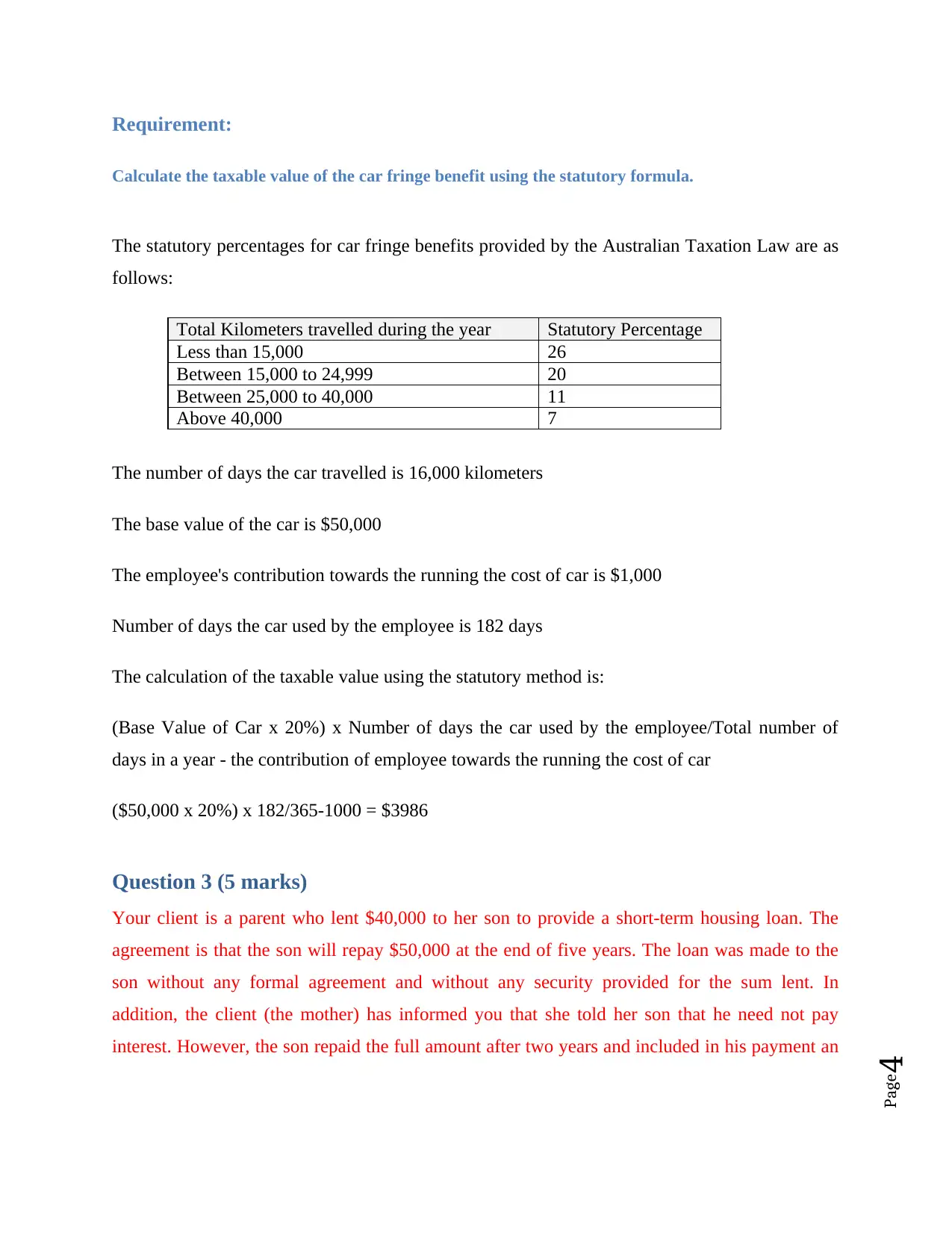
Page4
Requirement:
Calculate the taxable value of the car fringe benefit using the statutory formula.
The statutory percentages for car fringe benefits provided by the Australian Taxation Law are as
follows:
Total Kilometers travelled during the year Statutory Percentage
Less than 15,000 26
Between 15,000 to 24,999 20
Between 25,000 to 40,000 11
Above 40,000 7
The number of days the car travelled is 16,000 kilometers
The base value of the car is $50,000
The employee's contribution towards the running the cost of car is $1,000
Number of days the car used by the employee is 182 days
The calculation of the taxable value using the statutory method is:
(Base Value of Car x 20%) x Number of days the car used by the employee/Total number of
days in a year - the contribution of employee towards the running the cost of car
($50,000 x 20%) x 182/365-1000 = $3986
Question 3 (5 marks)
Your client is a parent who lent $40,000 to her son to provide a short-term housing loan. The
agreement is that the son will repay $50,000 at the end of five years. The loan was made to the
son without any formal agreement and without any security provided for the sum lent. In
addition, the client (the mother) has informed you that she told her son that he need not pay
interest. However, the son repaid the full amount after two years and included in his payment an
Requirement:
Calculate the taxable value of the car fringe benefit using the statutory formula.
The statutory percentages for car fringe benefits provided by the Australian Taxation Law are as
follows:
Total Kilometers travelled during the year Statutory Percentage
Less than 15,000 26
Between 15,000 to 24,999 20
Between 25,000 to 40,000 11
Above 40,000 7
The number of days the car travelled is 16,000 kilometers
The base value of the car is $50,000
The employee's contribution towards the running the cost of car is $1,000
Number of days the car used by the employee is 182 days
The calculation of the taxable value using the statutory method is:
(Base Value of Car x 20%) x Number of days the car used by the employee/Total number of
days in a year - the contribution of employee towards the running the cost of car
($50,000 x 20%) x 182/365-1000 = $3986
Question 3 (5 marks)
Your client is a parent who lent $40,000 to her son to provide a short-term housing loan. The
agreement is that the son will repay $50,000 at the end of five years. The loan was made to the
son without any formal agreement and without any security provided for the sum lent. In
addition, the client (the mother) has informed you that she told her son that he need not pay
interest. However, the son repaid the full amount after two years and included in his payment an
Paraphrase This Document
Need a fresh take? Get an instant paraphrase of this document with our AI Paraphraser
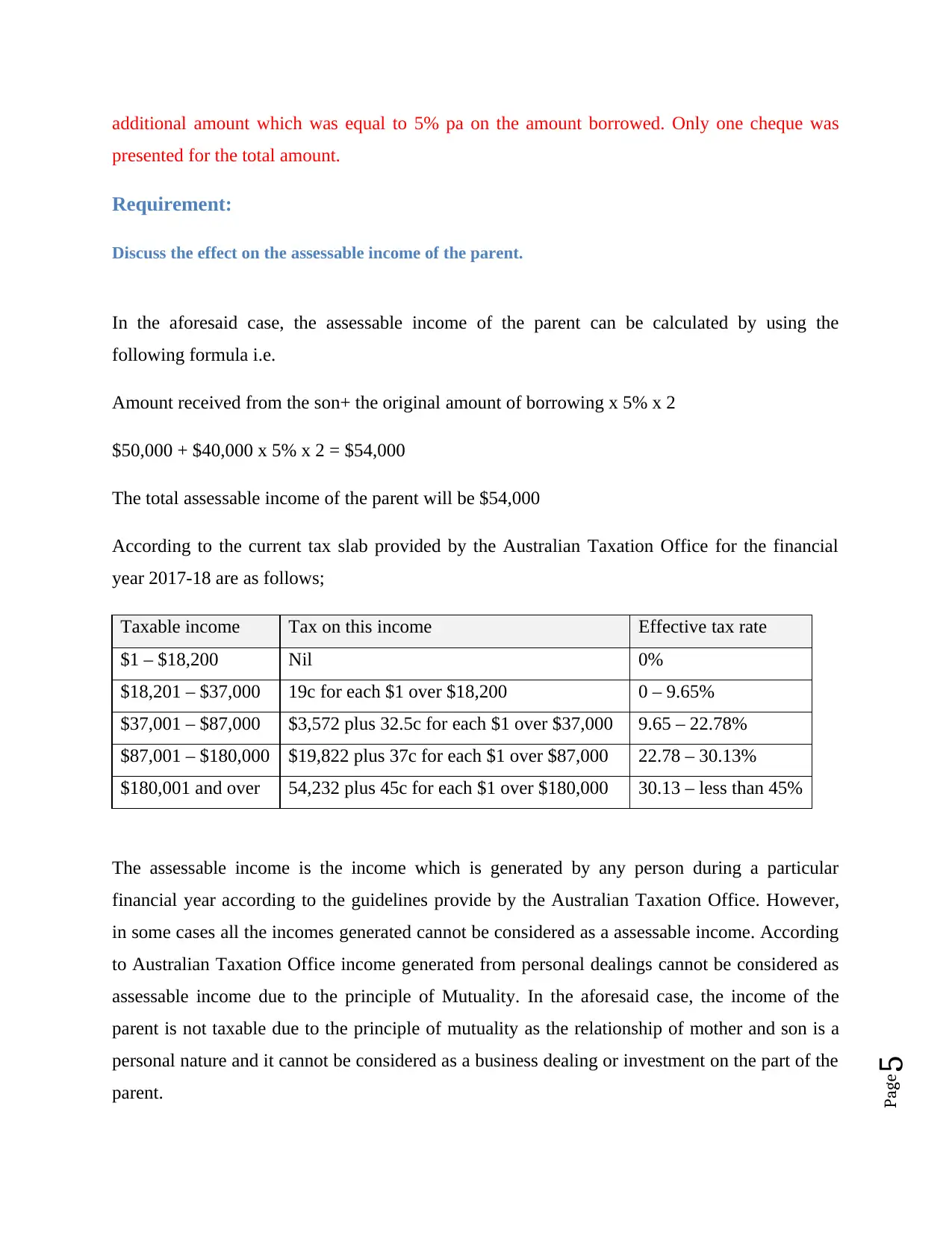
Page5
additional amount which was equal to 5% pa on the amount borrowed. Only one cheque was
presented for the total amount.
Requirement:
Discuss the effect on the assessable income of the parent.
In the aforesaid case, the assessable income of the parent can be calculated by using the
following formula i.e.
Amount received from the son+ the original amount of borrowing x 5% x 2
$50,000 + $40,000 x 5% x 2 = $54,000
The total assessable income of the parent will be $54,000
According to the current tax slab provided by the Australian Taxation Office for the financial
year 2017-18 are as follows;
Taxable income Tax on this income Effective tax rate
$1 – $18,200 Nil 0%
$18,201 – $37,000 19c for each $1 over $18,200 0 – 9.65%
$37,001 – $87,000 $3,572 plus 32.5c for each $1 over $37,000 9.65 – 22.78%
$87,001 – $180,000 $19,822 plus 37c for each $1 over $87,000 22.78 – 30.13%
$180,001 and over 54,232 plus 45c for each $1 over $180,000 30.13 – less than 45%
The assessable income is the income which is generated by any person during a particular
financial year according to the guidelines provide by the Australian Taxation Office. However,
in some cases all the incomes generated cannot be considered as a assessable income. According
to Australian Taxation Office income generated from personal dealings cannot be considered as
assessable income due to the principle of Mutuality. In the aforesaid case, the income of the
parent is not taxable due to the principle of mutuality as the relationship of mother and son is a
personal nature and it cannot be considered as a business dealing or investment on the part of the
parent.
additional amount which was equal to 5% pa on the amount borrowed. Only one cheque was
presented for the total amount.
Requirement:
Discuss the effect on the assessable income of the parent.
In the aforesaid case, the assessable income of the parent can be calculated by using the
following formula i.e.
Amount received from the son+ the original amount of borrowing x 5% x 2
$50,000 + $40,000 x 5% x 2 = $54,000
The total assessable income of the parent will be $54,000
According to the current tax slab provided by the Australian Taxation Office for the financial
year 2017-18 are as follows;
Taxable income Tax on this income Effective tax rate
$1 – $18,200 Nil 0%
$18,201 – $37,000 19c for each $1 over $18,200 0 – 9.65%
$37,001 – $87,000 $3,572 plus 32.5c for each $1 over $37,000 9.65 – 22.78%
$87,001 – $180,000 $19,822 plus 37c for each $1 over $87,000 22.78 – 30.13%
$180,001 and over 54,232 plus 45c for each $1 over $180,000 30.13 – less than 45%
The assessable income is the income which is generated by any person during a particular
financial year according to the guidelines provide by the Australian Taxation Office. However,
in some cases all the incomes generated cannot be considered as a assessable income. According
to Australian Taxation Office income generated from personal dealings cannot be considered as
assessable income due to the principle of Mutuality. In the aforesaid case, the income of the
parent is not taxable due to the principle of mutuality as the relationship of mother and son is a
personal nature and it cannot be considered as a business dealing or investment on the part of the
parent.
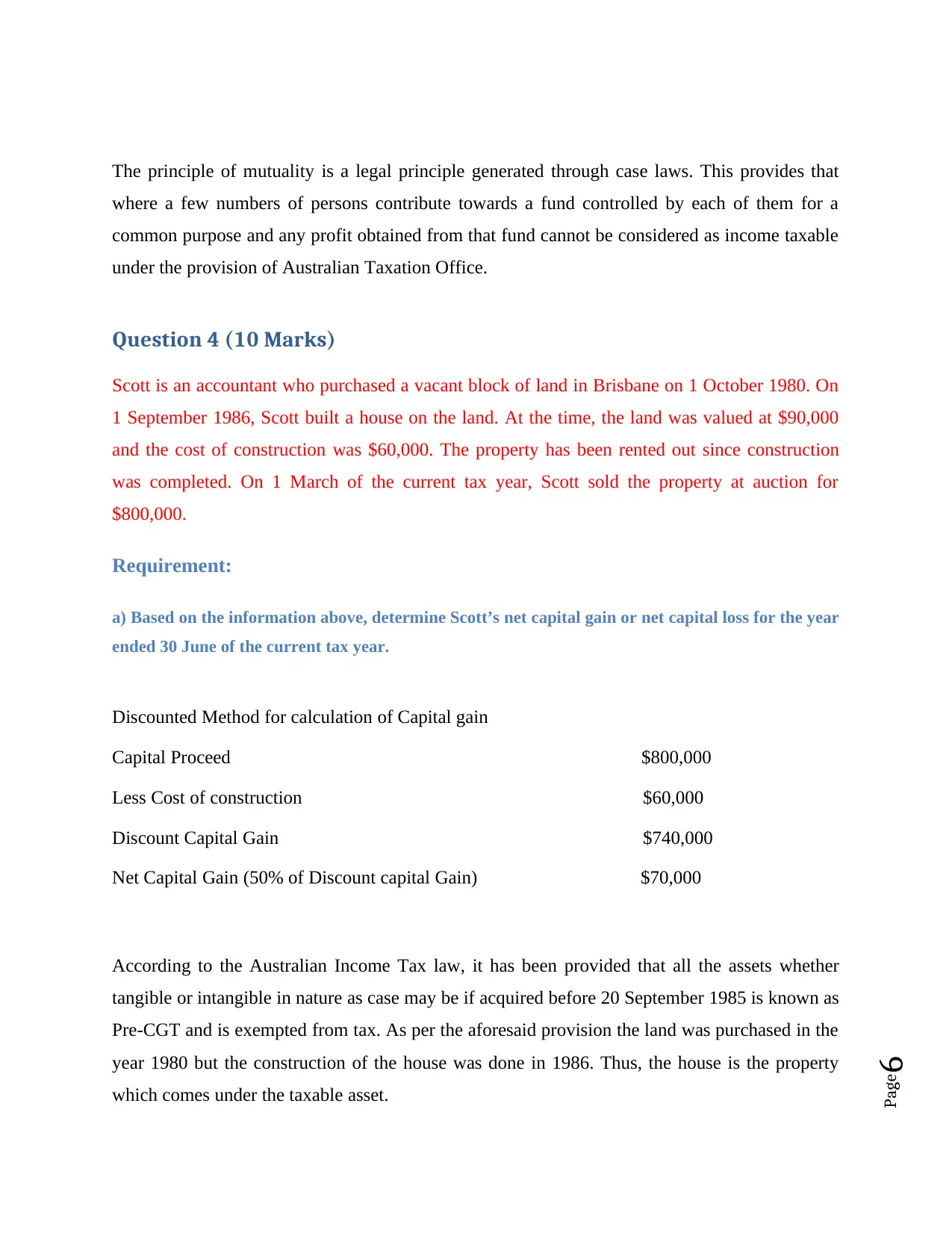
Page6
The principle of mutuality is a legal principle generated through case laws. This provides that
where a few numbers of persons contribute towards a fund controlled by each of them for a
common purpose and any profit obtained from that fund cannot be considered as income taxable
under the provision of Australian Taxation Office.
Question 4 (10 Marks)
Scott is an accountant who purchased a vacant block of land in Brisbane on 1 October 1980. On
1 September 1986, Scott built a house on the land. At the time, the land was valued at $90,000
and the cost of construction was $60,000. The property has been rented out since construction
was completed. On 1 March of the current tax year, Scott sold the property at auction for
$800,000.
Requirement:
a) Based on the information above, determine Scott’s net capital gain or net capital loss for the year
ended 30 June of the current tax year.
Discounted Method for calculation of Capital gain
Capital Proceed $800,000
Less Cost of construction $60,000
Discount Capital Gain $740,000
Net Capital Gain (50% of Discount capital Gain) $70,000
According to the Australian Income Tax law, it has been provided that all the assets whether
tangible or intangible in nature as case may be if acquired before 20 September 1985 is known as
Pre-CGT and is exempted from tax. As per the aforesaid provision the land was purchased in the
year 1980 but the construction of the house was done in 1986. Thus, the house is the property
which comes under the taxable asset.
The principle of mutuality is a legal principle generated through case laws. This provides that
where a few numbers of persons contribute towards a fund controlled by each of them for a
common purpose and any profit obtained from that fund cannot be considered as income taxable
under the provision of Australian Taxation Office.
Question 4 (10 Marks)
Scott is an accountant who purchased a vacant block of land in Brisbane on 1 October 1980. On
1 September 1986, Scott built a house on the land. At the time, the land was valued at $90,000
and the cost of construction was $60,000. The property has been rented out since construction
was completed. On 1 March of the current tax year, Scott sold the property at auction for
$800,000.
Requirement:
a) Based on the information above, determine Scott’s net capital gain or net capital loss for the year
ended 30 June of the current tax year.
Discounted Method for calculation of Capital gain
Capital Proceed $800,000
Less Cost of construction $60,000
Discount Capital Gain $740,000
Net Capital Gain (50% of Discount capital Gain) $70,000
According to the Australian Income Tax law, it has been provided that all the assets whether
tangible or intangible in nature as case may be if acquired before 20 September 1985 is known as
Pre-CGT and is exempted from tax. As per the aforesaid provision the land was purchased in the
year 1980 but the construction of the house was done in 1986. Thus, the house is the property
which comes under the taxable asset.
⊘ This is a preview!⊘
Do you want full access?
Subscribe today to unlock all pages.

Trusted by 1+ million students worldwide
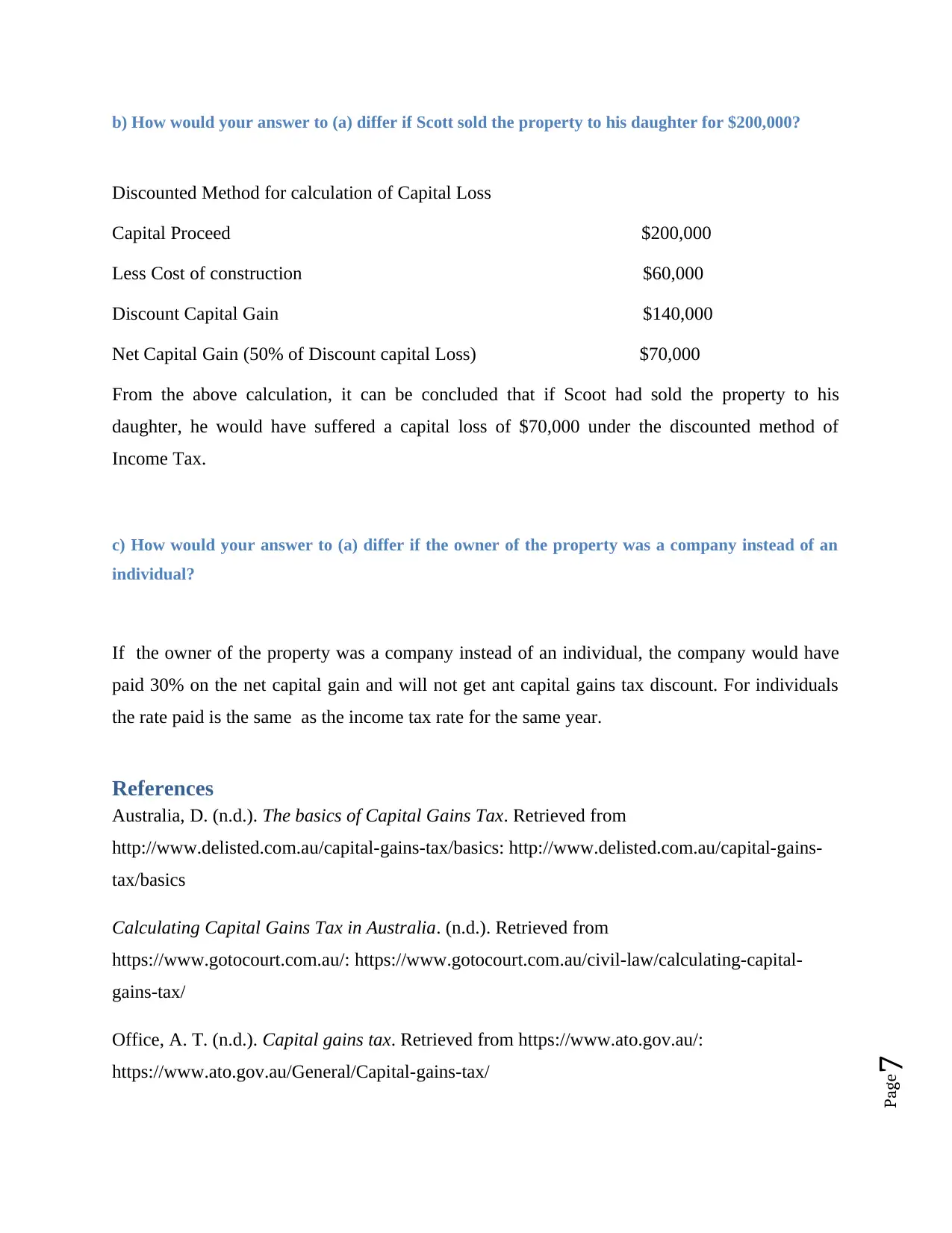
Page7
b) How would your answer to (a) differ if Scott sold the property to his daughter for $200,000?
Discounted Method for calculation of Capital Loss
Capital Proceed $200,000
Less Cost of construction $60,000
Discount Capital Gain $140,000
Net Capital Gain (50% of Discount capital Loss) $70,000
From the above calculation, it can be concluded that if Scoot had sold the property to his
daughter, he would have suffered a capital loss of $70,000 under the discounted method of
Income Tax.
c) How would your answer to (a) differ if the owner of the property was a company instead of an
individual?
If the owner of the property was a company instead of an individual, the company would have
paid 30% on the net capital gain and will not get ant capital gains tax discount. For individuals
the rate paid is the same as the income tax rate for the same year.
References
Australia, D. (n.d.). The basics of Capital Gains Tax. Retrieved from
http://www.delisted.com.au/capital-gains-tax/basics: http://www.delisted.com.au/capital-gains-
tax/basics
Calculating Capital Gains Tax in Australia. (n.d.). Retrieved from
https://www.gotocourt.com.au/: https://www.gotocourt.com.au/civil-law/calculating-capital-
gains-tax/
Office, A. T. (n.d.). Capital gains tax. Retrieved from https://www.ato.gov.au/:
https://www.ato.gov.au/General/Capital-gains-tax/
b) How would your answer to (a) differ if Scott sold the property to his daughter for $200,000?
Discounted Method for calculation of Capital Loss
Capital Proceed $200,000
Less Cost of construction $60,000
Discount Capital Gain $140,000
Net Capital Gain (50% of Discount capital Loss) $70,000
From the above calculation, it can be concluded that if Scoot had sold the property to his
daughter, he would have suffered a capital loss of $70,000 under the discounted method of
Income Tax.
c) How would your answer to (a) differ if the owner of the property was a company instead of an
individual?
If the owner of the property was a company instead of an individual, the company would have
paid 30% on the net capital gain and will not get ant capital gains tax discount. For individuals
the rate paid is the same as the income tax rate for the same year.
References
Australia, D. (n.d.). The basics of Capital Gains Tax. Retrieved from
http://www.delisted.com.au/capital-gains-tax/basics: http://www.delisted.com.au/capital-gains-
tax/basics
Calculating Capital Gains Tax in Australia. (n.d.). Retrieved from
https://www.gotocourt.com.au/: https://www.gotocourt.com.au/civil-law/calculating-capital-
gains-tax/
Office, A. T. (n.d.). Capital gains tax. Retrieved from https://www.ato.gov.au/:
https://www.ato.gov.au/General/Capital-gains-tax/
Paraphrase This Document
Need a fresh take? Get an instant paraphrase of this document with our AI Paraphraser
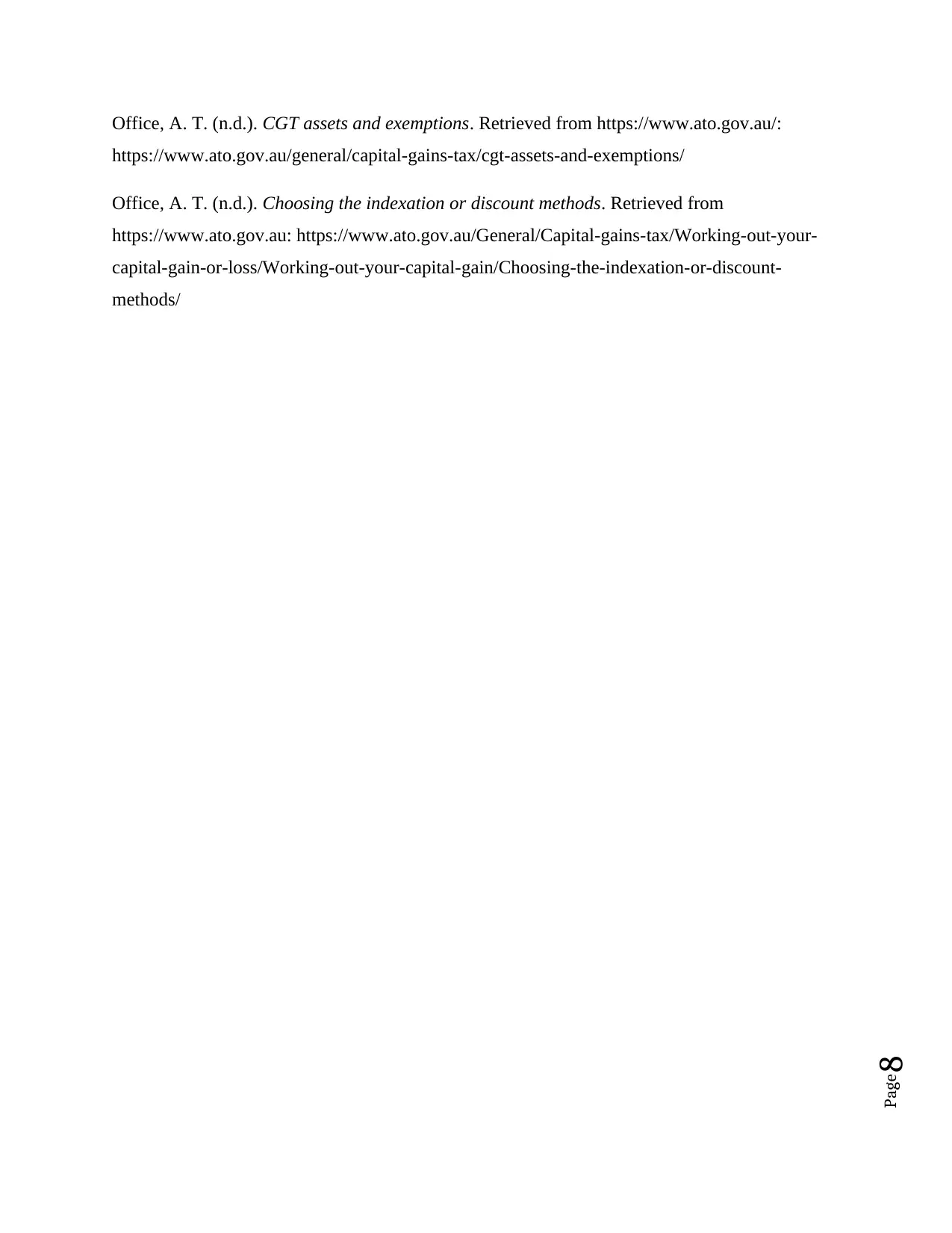
Page8
Office, A. T. (n.d.). CGT assets and exemptions. Retrieved from https://www.ato.gov.au/:
https://www.ato.gov.au/general/capital-gains-tax/cgt-assets-and-exemptions/
Office, A. T. (n.d.). Choosing the indexation or discount methods. Retrieved from
https://www.ato.gov.au: https://www.ato.gov.au/General/Capital-gains-tax/Working-out-your-
capital-gain-or-loss/Working-out-your-capital-gain/Choosing-the-indexation-or-discount-
methods/
Office, A. T. (n.d.). CGT assets and exemptions. Retrieved from https://www.ato.gov.au/:
https://www.ato.gov.au/general/capital-gains-tax/cgt-assets-and-exemptions/
Office, A. T. (n.d.). Choosing the indexation or discount methods. Retrieved from
https://www.ato.gov.au: https://www.ato.gov.au/General/Capital-gains-tax/Working-out-your-
capital-gain-or-loss/Working-out-your-capital-gain/Choosing-the-indexation-or-discount-
methods/
1 out of 8
Related Documents
Your All-in-One AI-Powered Toolkit for Academic Success.
+13062052269
info@desklib.com
Available 24*7 on WhatsApp / Email
![[object Object]](/_next/static/media/star-bottom.7253800d.svg)
Unlock your academic potential
Copyright © 2020–2025 A2Z Services. All Rights Reserved. Developed and managed by ZUCOL.





